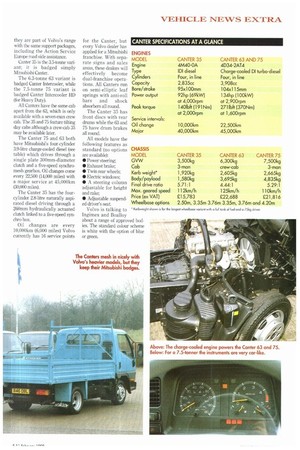Volvo Canters into the UK
Page 16

Page 17

If you've noticed an error in this article please click here to report it so we can fix it.
Three variants of Mitsubishi's Canter chassis-cab are now available through Volvo's UK truck dealer network in the first stage of the recently announced tie-up which could lead to a jointly developed truck in the UK's medium-weight sector...
by Charles Young and Toby Clark
• Volvo says its decision to sell 3.5, 6.3, and 7.5-tonne Canters (badged Mitsubishis) in mainland Britain alongside its own FLC offers customers a "one stop shop" from 3.5 tonnes upwards.
The deal has been made possible by a change in philosophy towards being a market-driven supplier," says Steve Kirk, business manager light trucks and part of the new light truck business unit. "Transport needs across Europe are changing," he adds. "Fleets are moving away from just having tractors and trailers...Volvo wants to be there to provide solutions to these customers."
The FLC will still be available;
Volvo believes it will appeal to a different sort of customer. "The Canter has more car-like appeal while the FLC has more traditional truck values," says Kirk.
By 2003 Volvo reckons the 3.5-tonne Canter will be taking 10% of the market with the 7.5tonner taking 5% and another 5% going to the FLC.
The Canter is targeted at car recovery, municipal, high street retail and third-part operators. Some of the first examples will go to BRS, which was recently bought by Volvo Contract Services. Volvo is offering a three year/100,000km warranty on the Canter, with a three-year/ unlimited-mileage anti-corrosion warranty on the cab.
The trucks will be sold as if they are part of Volvo's range with the same support packages, including the Action Service Europe road side assistance.
Canter 35 is the 35-tonne variant; it is badged simply Mitsubishi Canter.
The 6.3-tonne 63 variant is badged Canter Interco°ler, while the 7.5-tonne 75 variant is badged Canter Intercooler HD (for Heavy Duty).
All Canters have the same cab apart from the 63, which is only available with a seven-man crew cab. The 35 and 75 feature tilting day cabs although a crew-cab 35 may be available later.
The Canter 75 and 63 both have Mitsubishi's four-cylinder 3.9-litre charge-cooled diesel (see table) which drives through a single plate 300mm-diameter clutch and a five-speed synchromesh gearbox. Oil changes come every 22,500 (14,000 miles) with a major service at 45,000km (30,000 miles).
The Canter 35 has the fourcylinder 2.8-litre naturally aspirated diesel driving through a 260mm hydraulically actuated clutch linked to a five-speed synchro box.
Oil changes are every 10,000km (6,000 miles) Volvo currently has 16 service points for the Canter, but every Volvo dealer has applied for a Mitsubishi franchise. With separate signs and sales areas, these dealers will effectively become dual-franchise operations. All Canters run on semi-elliptic leaf springs with anti-roll bars and shock absorbers all round_ The Canter 35 has front discs with rear drums while the 63 and 75 have drum brakes all round.
All models have the following features as standard (no options are available):
• l'ower steering; • Exhaust brake;
• Twin rear wheels.,
• Electric windows; • A steering column adjustable for height and rake; • Adjustable suspended driver's seat.
Volvo is talking to Ingimex and Boalloy about a range of approv ies. The standard colour is white with the option or green.
CANTER DRIVING IMPRESSIONS
WITH ITS FORWARD-CONTROL LAYOUT and compact cab, the Carder looks like a typical Japanese-designed lied commercial. But we were pleasantly surprised by our experience of driving it, especially in 7.5-tome guise.
We first tried a short-wheelbase, box-bodied version of the Canter 35. Entry to the cab was easy, and the suspended driving seat is comfortable. The cab is not large, and the range of adjustment of the steering wheel is limited, but the driving position is reasonable.
The naturally aspirated diesel is a lithe noisy, and driveline noise levels are high at speed, but the Canter is not designed for motorway work: 60mph in top corresponds to a busy 4,000rpm and top speed is just 70mph (112lim/h).
The ride is generally OK—at least for the driver—and roll is well controlled, but the short wheelbase can lead to an unpleasant pitching sensation on bumpy Aroads. On the other hand, the timing circle is good—Mitsubishi claims 9.8m kerbto-kerb—and the steering is as fight as you would expect from a Japanese vehicle (but it could be more precise). The Canter 75 shares the same cab. but the engine note makes it immediately feel more modem. Unfortunately, the lack of synchromesh on first gear says the opposite (though the low second gear will tempt many drivers to forget first *together). With its longer wheelbase and a smart Boalloy "7.5-Liner" artainsider body, the Carder 75 feels steadier on fast roads, but the narrow-track leaf springs tend to encourage body roll.
is much more impressive than the 35's Be 75's direct-injection turbo-diesel unit, gaining revs rapidly to its red line of 3,000rpm and sounding less intrusive in the process.
The exhaust brake is a welcome feature, and should save on brake linings, but is of little use below 2,500rom.
CANTER SPECIFICATIONS AT A GLANCE
ENGINES MODEL Engine Type Cylinders Capacity Bore/stroke Power output Peak torque Service intervals: Oil change Major
CANTER 35 4M40-0A IDI diesel
Four, in line 2,835cc 95x1 00mm 92hp (69kW) at 4,000rpm 1401bit (191Nm) at 2,000rpm 10,000km 40,000km
CANTER 63 AND 75
4D34-2AT4 Charge-cooled DI turbo-diesel Four, in line 3,908cc 104x115mm 134hp (100kW) at 2,900rpm 271Ibft (370Nm) at 1,600rpm
22,500km 45,000km
CHASSIS MODEL GVW Cab Kerb weight* Body/payload Final drive ratio Max. geared speed Price (ex VAT) Wheelbase options CANTER 35 3,500kg 3-man 1,920kg 1,580kg 5.71:1 1 12km/h £15,783 2.50m, 3.35m
CANTER 63 CANTER 75
6,300kg 7,500kg crew-cab 3-man 2,605kg 2,665kg 3,695kg 4,835kg
4A4:1 5.29:1 125km/h 110km/h
£22,688 £21,816
3.76m 3.35m, 3.76m and 4.20m
Kerbweighi shown is For the longest wheelbase variant with a full tank of fuel and o 75kg driver.








































































































